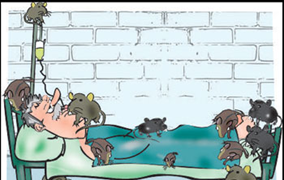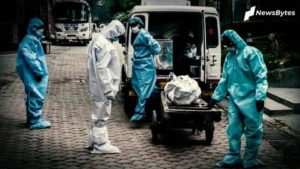Hospitals are supposed to be visiting places for patients, but these days invasive pests to have started visiting them.
Rodents like rats, mice, squirrels, etc. are easily found in the areas of hospitals. They are just not found but are known to cause a nuisance in the areas of hospitals.
What attracts these pests in the hospitals?
 They get attracted to the food available in the hospital canteens. Caretakers of patients carry food along with them in the hospitals. Many times the carried food is dropped on the flooring. The pest easily gets attracted to these sources of food.
They get attracted to the food available in the hospital canteens. Caretakers of patients carry food along with them in the hospitals. Many times the carried food is dropped on the flooring. The pest easily gets attracted to these sources of food.
There are limited trash bins available in the hospital areas, which get flooded with the trash. The pesky rodents easily get attracted to this.
There are polymeric applications available such as wires and cables, pipes, surgical instruments etc. available in hospitals to which the pests get attracted. The pests are fond of the colors and smell of the polymeric applications which easily brings the pests in the hospitals.
The hospitals provide with a safe nesting area for rodents. The ceilings, decks, laundry areas, kitchens etc. are places where the rodents nest. The atmosphere in the hospitals is preferable for the rodents to rest.
Their nuisance does not stop just damaging the materials from the hospital but also goes up to threatening patient’s lives, and this is for real!
Indore: Rodents attack COVID-19 victim’s body, probe ordered
Written by
Shalini Ojha

A family in Indore, who lost a member to the coronavirus, was given another shock when they saw that his body was seemingly eaten by rodents.
The deceased, 87-year-old Naveenchandra Jain, breathed his last on Sunday at Unique Hospital, and his family was handed over the body in a white body bag a day later.
On seeing the body’s condition, the family obviously fumed.
When they received his mortal remains, the family saw Jain’s toes and face had bite marks.
Rats nibble on dead baby’s face in Telangana’s Narsapur hospital
The hospital has denied negligence on its partImage for representation
In a shocking incident, the body of a three-month-old baby was found chewed up by rats in the mortuary at Government Area Hospital in Narasapur in Telangana’s Medak district.
According to reports, the baby girl was identified as the daughter of P Kishan and Surekha. The couple had been living separately due to a family dispute.
The police said that the infant, identified as Gnathi, had been ill for a few days with a high fever, and doctors had referred her to Niloufer Hospital in Hyderabad.
Since it was late on Thursday, the doctors said that an autopsy would be conducted the next day.
When the mother checked on the baby on Friday morning, Surekha found the baby’s face disfigured, as rats had chewed it off.
“Our daughter did not have any marks on her body. She was wrapped in a cloth and taken to the mortuary. I asked for a post-mortem only so that my husband wouldn’t say that I killed our baby due to negligence. I didn’t know it would result in this,” the mother was quoted as saying.
Hospitals are sensitive places where patients come to get a cure from the diseases they are suffering from. But what when the patients come across the rodents which are carriers of more than 200 deadly pathogens.
The sensitive places like hospitals should be kept rodent-free to avoid any mishap due to pest presence.
To keep rodents away from hospitals many ineffective control measures are used traditionally. These methods include the use of rat traps which do not work once mechanical damage is caused to them. The hospitals are fumigated, which is the most dangerous method of pest control. Glue boards are used that can be dangerous if a patient accidentally sticks to it. Rat poisons are used which are the potential of killing rodents and spreading the deadly diseases.
In a place, like a hospital effective and eco-friendly measures are necessary to keep these pests at a bay.
Is there such a solution available?
Yes, C Tech Corporation’s RodrepelTM is the best solution to keep rodents away from the hospital and hence from human contact.
RodrepelTM is a low-toxic, non-hazardous, and rodent aversive. This product works on the mechanism of repellency. It does not harm or kill the target species but generate fear or trigger temporary discomfort within the pests that keep the pests away from the application. The unpleasant experience with the product is imprinted within an animal’s memory and passed on its progeny.
RodrepelTM is available in liquid concentrate which can be diluted in paints and can be applied on the interior and exterior of hospitals. The product is safe for use in the patient’s room and operation theatres. The product can be used in the medicine storage areas to keep the pests out of these places. The kitchen and pantry can be painted using this product. The laundry area is dreaded with pests as well where this product can be applied.
The product is available in lacquer form which is a direct application. The lacquer can be applied to the furniture and other wooden accessories used in hospitals. It can be applied to already installed wires and cables, polymeric utility pipes, and equipment used in hospitals. The product is compatible with most of the surfaces like metal, wood, concrete, polymer, ceramic, etc.
The product available in the form of masterbatch can be incorporated into the polymeric applications like wires and cables, pipes, equipment, and accessories from hospitals while they are manufactured.
RodrepelTM triggers a fear response in rodents thus protecting the application. It causes severe temporary distress to the mucous membrane of the rodents due to which the pest stays away from the application. The product triggers an unpleasant reaction in case if the pest tries to gnaw away the application. After encountering the above-mentioned emotions, the animal instinctively perceives it with something it should stay away from and stores this information for future reference. The fact that certain rodents are repelled is mimicked by other rodents as well. Thus, the other rodents too stay away from the applications. The unpleasant experience is imprinted within the animal’s memory and passed on to its progeny.
The product is compliant with RoHS, RoHS2, RoHS3, REACH, APVMA, NEA, BPR, and FIFRA exempted.
If you are facing problems from these pests that contact us on technical.marketing@ctechcorporation.com
Also, visit our websites:
http://www.ctechcorporation.com/
http://www.rodrepel.com/
http://www.termirepel.com/
http://www.combirepel.com/
Follow our Facebook pages at:
1] https://www.facebook.com/Combirepel-411710912249274/
2] https://www.facebook.com/Termirepel-104225413091251/
3] https://www.facebook.com/Rodrepel-120734974768048/
Follow us on our Twitter pages at:
1] https://twitter.com/rodrepel
2] https://twitter.com/termirepel
3] https://twitter.com/combirepel
